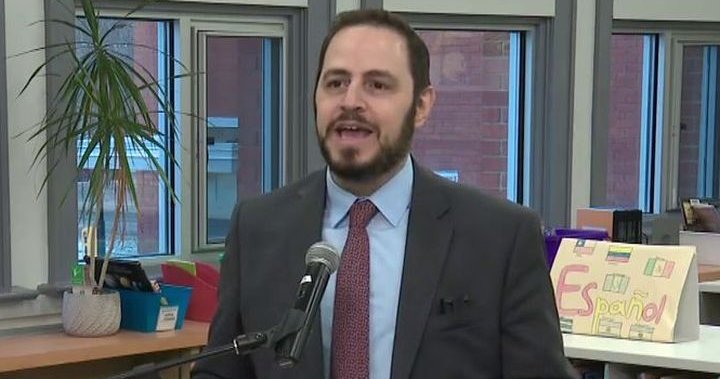As Albertans face a worrying trend of classroom disruptions, the provincial government has taken what many educators describe as an overdue step toward addressing school violence. Yesterday, Education Minister Demetrios Nicolaides announced a comprehensive approach aimed at reducing incidents across Alberta schools, following months of teacher concerns and parent advocacy.
“Our goal is to ensure every classroom becomes a safe space for learning,” Nicolaides stated during the press conference in Edmonton. “The data shows a concerning pattern that demands immediate action.”
The announcement comes after the Alberta Teachers’ Association reported a 37% increase in violent incidents against teachers over the past three years. According to their survey of 2,900 educators, nearly 68% of respondents had experienced or witnessed some form of physical aggression in their schools.
I spoke with Janet Morris, a Grade 8 teacher at McKenzie Middle School in Calgary, who described the reality behind these statistics. “We’re seeing everything from verbal threats to physical confrontations that disrupt entire classrooms,” she told me during a phone interview. “Sometimes it’s just one student in crisis, but that impacts twenty-five others trying to learn.”
The new provincial framework requires all school divisions to implement violence prevention strategies by January 2025. These strategies must include comprehensive incident reporting mechanisms, staff training on de-escalation techniques, and clearer protocols for responding to serious disruptions.
Premier Danielle Smith defended the timeline during question period last week, arguing that “meaningful systemic change requires careful implementation rather than rushed solutions.” Opposition critics, however, question why the government waited until violence statistics reached concerning levels before taking action.
NDP education critic Sarah Hoffman called the response “reactionary rather than preventative” and pointed to previous budget cuts that reduced support staff positions. “Teachers have been raising alarms about classroom violence for years while resources were simultaneously being pulled from the system,” Hoffman said.
Beyond the political debate lies a more complex reality that parents, teachers and students navigate daily. School violence isn’t merely a disciplinary issue but often connects to broader social challenges including mental health concerns, family instability, and pandemic-related learning disruptions.
Dr. Erin McPherson, child psychologist at the University of Alberta, explains: “What we’re seeing in classrooms often reflects unaddressed trauma or developmental needs. The pandemic created significant gaps in social skills development for many children.”
The Alberta School Councils’ Association, representing parent advisory groups, has generally welcomed the new framework while expressing concerns about implementation resources. Their president, Brandi Rai, noted that “policies without proper funding and support for front-line staff rarely achieve their intended outcomes.”
Provincial funding details remain somewhat vague, with Nicolaides committing to $5 million for initial training programs while indicating that school boards should incorporate violence prevention within existing operational budgets. This approach has raised eyebrows among district administrators already managing tight financial constraints.
Calgary Board of Education trustee Laura Hack acknowledged the challenge during their monthly board meeting: “We appreciate provincial leadership on this issue, but meaningful implementation requires resources. Safe schools aren’t just about policies – they require adequate staffing and support systems.”
The framework also introduces a standardized reporting system that will track violent incidents across the province, providing what officials call “data-informed decision making” for future interventions. Previously, inconsistent reporting methods made it difficult to compare incidents between districts or identify provincial trends.
For students themselves, the conversation about school safety carries mixed emotions. When I visited Northern Lights High School in Edmonton last week, Grade 11 student council president Jamal Williams shared perspectives from his peers: “Most of us want stricter consequences for serious disruptions, but we also understand some kids are going through stuff and need help, not just punishment.”
This balance between accountability and support represents the central challenge for educators implementing the new provincial framework. The policy explicitly requires schools to develop both intervention protocols for disruptive behaviors and support systems for students exhibiting concerning patterns.
Parent advocacy groups like Alberta Parents for Positive Learning Environments have championed this dual approach. Their spokesperson, Karen Fitzgerald, told me: “We’ve always maintained that effective discipline must include appropriate consequences alongside meaningful support. Children exhibiting violent behaviors need both boundaries and resources.”
The Alberta School Boards Association has pledged to work closely with the ministry on implementation, though several rural districts have expressed concerns about access to specialized training and mental health resources in remote communities.
While the provincial announcement represents a step forward, education experts caution that addressing school violence requires sustained commitment beyond policy announcements. University of Calgary education professor Dr. James Wilson notes that “successful violence reduction programs typically require 3-5 years of consistent implementation before showing significant results.”
For teachers like Morris, the initiative offers cautious hope. “We need this framework to translate into real support in our classrooms – not just another binder of policies that sits on a shelf,” she said. “Our students deserve learning environments where everyone feels safe.”
As Alberta moves forward with this initiative, the success of the framework will ultimately depend on the resources, training and community engagement that support it. The provincial government has promised quarterly updates on implementation progress, with the first comprehensive data review scheduled for June 2025.
In the meantime, teachers, parents and students continue navigating classroom dynamics with the tools currently available – hoping this new approach delivers the safer learning environments that Alberta’s education system aims to provide.






